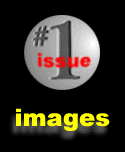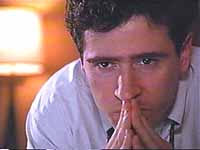









































| Quiz Show as Persuasive Docudrama
by Steve Lipkin | |
|
Due to the hybrid nature of its form, docudrama demands a particular kind of suspension of disbelief from its audience. The docudrama viewer becomes immersed in a blend of documentary and melodrama. One's involvement begins by accepting certain hypothetical premises implicit in this coupling. We are asked to accept that in this case re-creation is a necessary mode of presentation. If we accept the historical substance of the pre-filmic events, then we are also asked to grant that these events might have happened in much the way we are about to see them depicted. | |
John Turturro as Herbert Stempel in Quiz Show. |
|
Rob Morrow as Rick Goodwin in Quiz Show. | Through its cinematic presentation of Van Doren and Goodwin, Quiz Show adds a broader set of arguments regarding the implicit anti-Semitism in the network's actions to the re-creation of known history, the corruption and greed underlying the scandal. The proximity of re-creation warrants the film's moral position. From the premise of the "look" of the time, setting, characters and actions, the film suggests that Van Doren's downfall results from a double moral weakness. His cloistered office, family home, and upper-class Eastern family life can't shield him from being exposed as a cheater. Perhaps worse, however, is that he would allow himself to benefit from and then be ruined by the anti-Semitism of others, a prejudice, his friendship with Rick Goodwin would suggest, he himself does not necessarily share.
The action of Quiz Show's argument, its infusion of a particular moral view into re-creating documented history, illustrates the most basic issue raised by modeling relations in docudrama. Modeled warrants are entirely iconic and function by virtue of resemblance to their referents. The first question these warrants raise then becomes understandably, "resemblance to what"? Quiz Show's arguments suggest that resemblance to people and setting in modeled docudrama proposes a more limited, clearly defined set of claims than depicted resemblances to actions and events. The second set of appearances, dependent upon the first, will then be more likely to raise ethical implications of historical representation.
The interrelationship of iconic and indexical material is crucial to the persuasive power of film docudrama and associates cinematic proximity with the moral truth the film will advocate. Several strategies can create the sense of proximity that invites a docudrama viewer's suspension of disbelief. A strategy of modeling, such as the kind offered by Quiz Show, builds upon accepting close resemblances. Also possible are alternating indexical and iconic material as distinct sequences, and profilimic interactions of actual elements (settings; nonactors) with created/re-created elements within a scene. Several implications arise from these modeling, sequencing, and interaction strategies that link re-creation and actuality. First, the warrants can be interdependent. Sequencing relies upon modeled material, and interaction incorporates both models and sequences. Second, proximity increases and therefore strengthens as strategies shift to the more complex relations of sequencing and interaction. Third, as proximity strengthens, so does the warrant; therefore, so does the apparent validity of the argument and ultimately the film's potential persuasive power.
The sense that docudramas such as Quiz Show show us what "really happened" derives, then, from the warranting strategies that link documentary material and melodramatic perspective. The cues that signal that models, sequences, and interactions have shown us a logical path from actual premise to melodramatic conclusion set up an almost purely cinematic process of persuasion, a spatial association of what was "there" with the sense the film suggests we make of it. Docudrama warrants employ strategies based upon perceived proximities, so that docudrama, at its most powerful, convinces us that it is properly both logical and emotional to associate cinematic proximity with moral truth.
Steve Lipkin teaches film and video at Western Michigan University. His discussion of Quiz Show is an excerpt from a longer study of film docudrama that he is currently preparing for publication. Go to footnotes. Photo Credits: Hollywood Pictures Home Video. |
 |
 |
 |
 |
 |
 |
 Re-creation and fictionalization will warrant (justify) suspension of disbelief to the extent that the resulting docudrama indicates its connections to actuality. As it imitates the look and sound of past events, docudrama both models and interprets its subject. Modeling allows one of several possible links between actuality and re-creation. Robert Redford's Quiz Show (1994) offers a case study in how modeling warrants the larger arguments this docudrama makes.
Re-creation and fictionalization will warrant (justify) suspension of disbelief to the extent that the resulting docudrama indicates its connections to actuality. As it imitates the look and sound of past events, docudrama both models and interprets its subject. Modeling allows one of several possible links between actuality and re-creation. Robert Redford's Quiz Show (1994) offers a case study in how modeling warrants the larger arguments this docudrama makes.
 Quiz Show
Quiz Show
 Consistent with preexisting accounts, the film shows Van Doren replacing Herbert Stempel as a contestant on Twenty-one. Stempel's anger at the dismissive treatment he receives leads to the charges he brings publicly, contributing to the subsequent series of investigations, first by a New York grand jury, then by a House of Representatives special subcommittee on legislative oversight
Consistent with preexisting accounts, the film shows Van Doren replacing Herbert Stempel as a contestant on Twenty-one. Stempel's anger at the dismissive treatment he receives leads to the charges he brings publicly, contributing to the subsequent series of investigations, first by a New York grand jury, then by a House of Representatives special subcommittee on legislative oversight  The film departs from the general tenor of printed accounts and establishes a more unique perspective by underlining Stempel's Jewishness and his claims of anti-Semitism in the rigging of the shows
The film departs from the general tenor of printed accounts and establishes a more unique perspective by underlining Stempel's Jewishness and his claims of anti-Semitism in the rigging of the shows  Quiz Show further departs from established historical accounts by asserting that Van Doren was in fact intellectually and visually comparable to the scandal's primary investigator. Scenes scrupulously give "Charlie" and "Rick" equal visual weight as they test each other. During a lunch at the Athenaeum Club (Van Doren orders a Waldorf salad, Goodwin the Reuben) an exchange of similarly composed close-ups shows that Goodwin refuses to be intimidated by Mark Van Doren, Charlie's famous father, in pointing out the ethnically segregated nature of the clientele. The film employs a similar cinematically dramatic strategy during a poker game when Charlie and Rick confront each other about "lying" and "bluffing." Reinforcement of the visual equality of investigator and the one investigated also occurs when Goodwin reluctantly must serve Van Doren with a subpoena to appear before the House subcommittee. The leading two-shot shows both men to be dressed almost identically as they walk and discuss how they've come to be on opposite sides of legal and moral issues stemming from the choice of wealth and fame on the one hand, and retaining one's integrity on the other.
Quiz Show further departs from established historical accounts by asserting that Van Doren was in fact intellectually and visually comparable to the scandal's primary investigator. Scenes scrupulously give "Charlie" and "Rick" equal visual weight as they test each other. During a lunch at the Athenaeum Club (Van Doren orders a Waldorf salad, Goodwin the Reuben) an exchange of similarly composed close-ups shows that Goodwin refuses to be intimidated by Mark Van Doren, Charlie's famous father, in pointing out the ethnically segregated nature of the clientele. The film employs a similar cinematically dramatic strategy during a poker game when Charlie and Rick confront each other about "lying" and "bluffing." Reinforcement of the visual equality of investigator and the one investigated also occurs when Goodwin reluctantly must serve Van Doren with a subpoena to appear before the House subcommittee. The leading two-shot shows both men to be dressed almost identically as they walk and discuss how they've come to be on opposite sides of legal and moral issues stemming from the choice of wealth and fame on the one hand, and retaining one's integrity on the other.